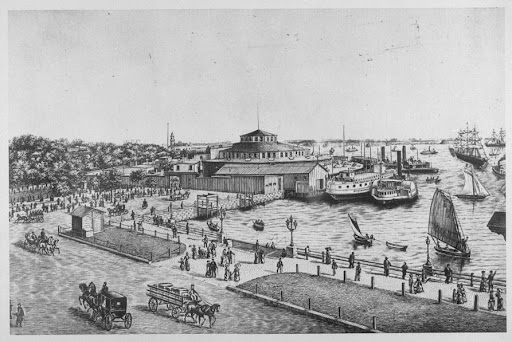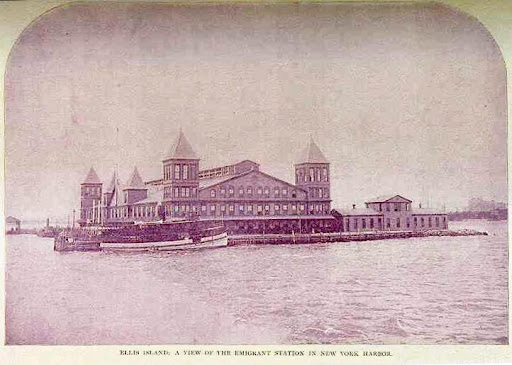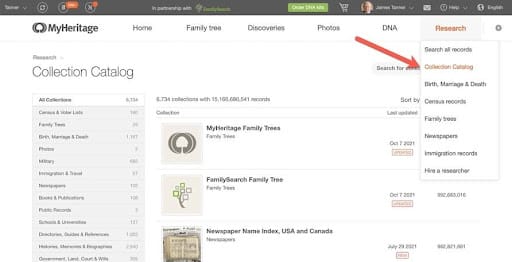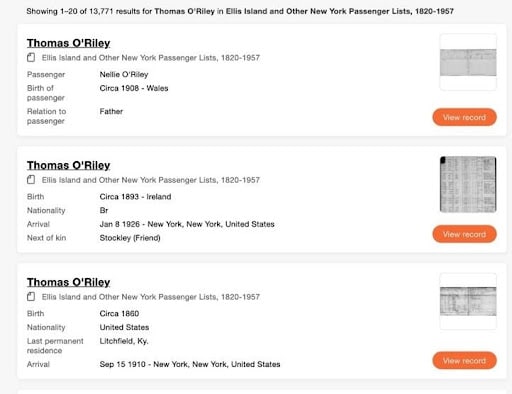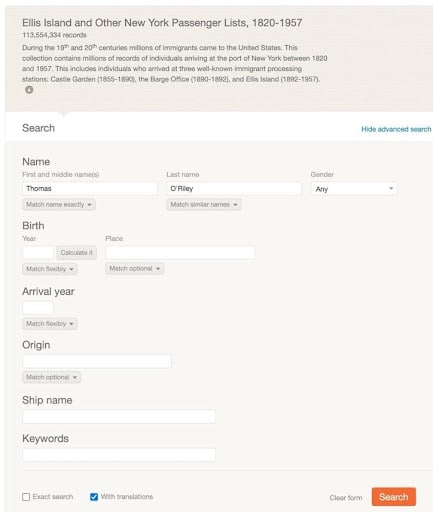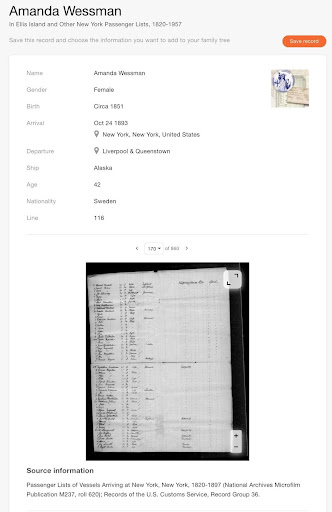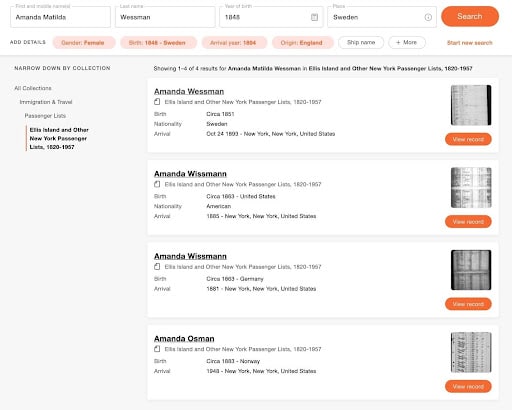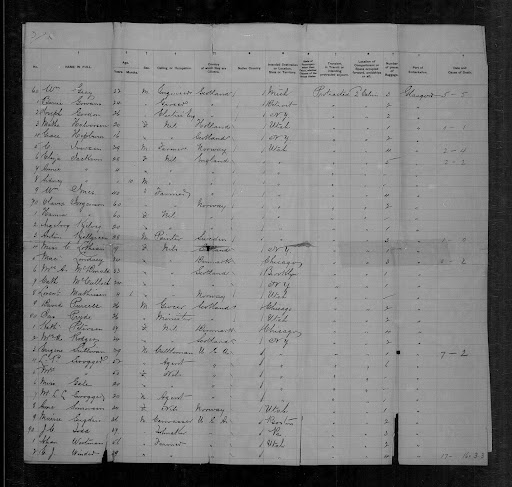Coming to America: The Legacy of Castle Garden and Ellis Island
- By James L. Tanner ·
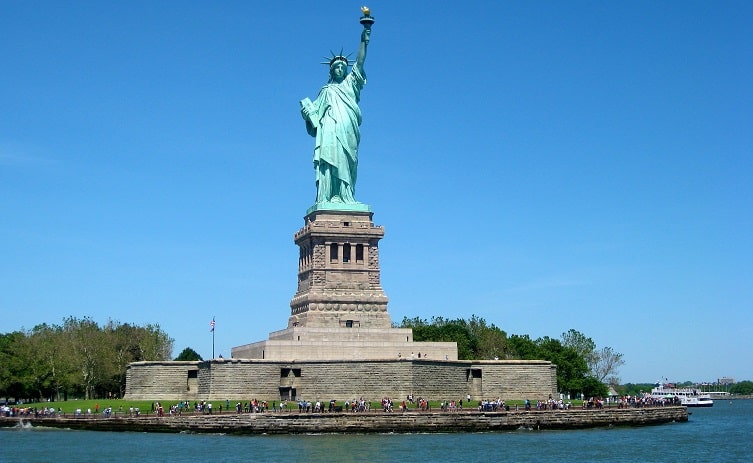

The following article was contributed by James L. Tanner, veteran genealogist and researcher.
Between the years of 1855 and 1954, it is estimated that as many as 20 million or more immigrants entered the United States and disembarked at the immigrant processing stations at Castle Garden and Ellis Island. Sailing by the Statue of Liberty became part of their immigration experience in 1886 when the statue was dedicated.
The original Castle Garden building was a military fort built between 1808 and 1811. It was first named the West Battery and sometimes also called the Southwest Battery. By 1815, West Battery was renamed Castle Clinton, its current official name, in honor of New York City Mayor DeWitt Clinton, who eventually became Governor of New York. The land area where the Castle Garden building is located is called “The Battery.” Castle Garden or Castle Clinton became the main immigrant entry point into the United States from August 3, 1855, to April 18, 1890. However, the Ellis Island facility was not opened until 1892 and for those two years, the immigrants were processed through the U.S. Barge Office on the U.S. Customs Barge anchored off The Battery. What is left of the original building is now part of Castle Clinton National Monument and is administered by the National Park Service. The original immigration records are preserved by the United States National Archives and Records Administration.
Construction began on the immigration station on Ellis Island in 1890 and the station opened on January 1, 1892. The first immigrant processed through the newly opened station was Annie Moore, a 17-year-old girl from Cork, Ireland. The original building was destroyed by a fire on June 15, 1897. Over 1.5 million records were lost.
Immediately after the fire, construction began on the new building, which opened on January 1, 1900. It processed 2,251 immigrants on the first day and nearly 450,000 the first year. Some of the earliest records were lost in the fire that destroyed the first Ellis Island building as well as about 1.5 million records of immigrants from January 1, 1892 to June 15, 1897, but millions of the surviving immigration records are a treasure trove of information for genealogical research.
Many genealogical researchers have family lines that end with an immigrant. Learning about how to find immigration records is a good first step to discovering your immigrant ancestors.
Basic immigrant research terminology
There are a few important terms that you should be familiar with before beginning your search. Below is a short list of those terms. For a more extensive list of immigration terms, see: Glossary of Common Legal Terms.
Immigrant: A general term that refers to people who enter a country for the purpose of remaining in the country for an extended period.
Emigration: Leaving one’s native country to settle in another.
Immigration: The international movement of people to a destination country of which they are not natives or where they do not possess citizenship to settle as permanent residents or naturalized citizens.
Naturalization: The process by which a foreign-born individual becomes a citizen of the United States.
Ship passenger list: A list made by the shipping company with information about the voyage, including the vessel and master’s names, port of embarkation and arrival, and the date of arrival. Passenger information required name, age, sex, occupation, country of origin, destination, and circumstances of death during the voyage, when applicable. This information was required subsequent to the passage of a law in the United States called the Steerage Act of 1819.
Ship manifest: A manifest, customs manifest, or cargo document is a document listing the cargo, passengers, and crew of a ship. A manifest may contain the same or different information found on a passenger list.
Finding immigration records
The first general immigration laws in the United States were passed in 1882, and immigration laws became more and more restrictive during the 1900s. Consequently, researching immigrants gets harder as you go back in time. However, records of passengers arriving in New York and elsewhere began much earlier, even as early as the 1500s. These records are generically known as “passenger arrival records” and they can provide information for genealogical research that includes the following:
- A person’s nationality and place of birth
- Ship name and date of entry to the United States
- Age, height, eye, and hair color
- Profession
- Place of last residence
- Name and address of relatives they are joining in the U.S.
- Amount of money they are carrying, etc.
The United States National Archives has a specialized, searchable database with 604,596 persons listed who arrived in the Port of New York, from 1846–1851. See the Access to Archival Databases (AAD). This database has 604,596 records in sections dedicated to immigrants who identified themselves as from Germany or a “German” state, city, or region, Russia, Italy, and Ireland. The National Archives also has several web pages dedicated to immigration records. See Immigration Records.
The Castle Garden website has a free searchable database that contains entries for 10 million immigrants from 1830 through 1892, the year Ellis Island opened. Searchable by passenger name, the database provides information including age, sex, literacy, occupation, country of origin, port of embarkation, date of arrival into New York, and ship name. See http://www.castlegarden.org/
In addition, Ellis Island has an online searchable database that was created by the Statue of Liberty/Ellis Island Foundation and contains information about 22.5 million arrivals to New York between 1892–1924. Registration is required, but free, and you can view scanned images of actual passenger manifests. You can also purchase copies of the images through the site. See https://heritage.statueofliberty.org/passenger
Researching an immigrant ancestor on MyHeritage
Many of the large, online genealogy websites have databases that contain immigrant and or passenger list information. MyHeritage has a huge collection containing millions of records about immigration and travel. To access these records directly, you click on the Research tab located at the top of the pages and select the Collection Catalog.
Then, on the left-hand side of the screen, choose “Immigration and travel,” and you will see the list of what is currently available. At the time this article was written, there were 57 collections with over 181 million records.
The first collection listed is Ellis Island and Other New York Passenger lists, 1820-1957, and includes individuals who arrived at the three well-known immigrant processing stations: Castle Garden (1855-1890), the Barge Office (1890-1892), and Ellis Island (1892-1957).
How do we go about finding an immigrant ancestor using this helpful collection?
It may seem obvious to just look for the immigrant’s name in the collection, but reality is never as simple as it might seem. The general rule for discovering information about an immigrant is to start in the country of arrival.
Let’s suppose that you are looking for your ancestor named Thomas O’Riley who you believe came from Ireland sometime in the 1800s. You decide to look for him in the MyHeritage database. If you simply enter his name, the search engine will pull up 13,771 results:
If your ancestor’s name is unique, this may not be an issue, but in most cases, you’ll need to have additional details to narrow down the results and search successfully.
Here are all the fields that MyHeritage suggests for your search:
You will need to find some of the basic details suggested here before you have enough information to search the passenger lists.
In the United States, the Federal Population Census records in the years 1900, 1910, 1920, and 1930 show the year of immigration and whether the person was a naturalized citizen. This makes a census search a priority for those immigrants who lived in the United States during those years. However, even if you add in the information for an immigrant from a census record, you may still have a hard time finding your immigrant on the passenger lists.
An example
One of my wife’s ancestors, Amanda Matilda Hall Wessman, came from Sweden to the United States in 1893. Here she is in the U.S. Census record for 1920 in Salt Lake City, Utah.
From this entry, we have a name, a place of residence, an approximate year of birth and birthplace, an arrival year, and that she is still an alien or not a naturalized citizen. Now we can do a search in the MyHeritage Collection for Ellis Island and Other New York Passenger Lists, 1820-1957. I am also going to guess that she sailed from England to the United States, because the most common port for immigrants from Scandinavia was through Liverpool, England. If I did not know that, I could leave the spaces blank.
Here is the entry which happens to be the first one that came up from the search.
My guess about the port of departure was correct. Now that we have the ship manifest or passenger list, we can see that the census record was wrong. The immigration date was in 1893 — arrival on October 24, 1893, to be exact. We can also see the name of the ship, the Alaska. She was traveling with one of her sons, Joseph. This helps to confirm that we have the right person.
It would be helpful if we had enough information to find all our immigrants, but note that MyHeritage found only 3 other records that came close to this entry. The decisive factor in eliminating the other three entries was having an estimated birth date and place.
Here are the 4 entries and the final search terms I used to search for Amanda Matilda Hall Wessman.
We can now use this same information to look for other family members who may also have immigrated about the same time. That may require a search for United States Federal Census records from additional years, or finding other records about the family. A further general search on MyHeritage shows her husband’s name was Johan Bengtsson Wessman, born in 1840 in Sweden. We can try to find his immigration record from the same collection on the MyHeritage website. Here is the MyHeritage response passenger list for Johan Westman with a destination of Utah. This is most likely the passenger list for Amanda’s husband.
Doing genealogical research is a process and it does take some time and study to learn the basics, especially for doing research for immigrants. Fortunately for those doing research in the United States, MyHeritage and other websites have substantial collections of passenger lists and other useful topics that can assist your research. Every record you find and every piece of added information will help to find even more information.
